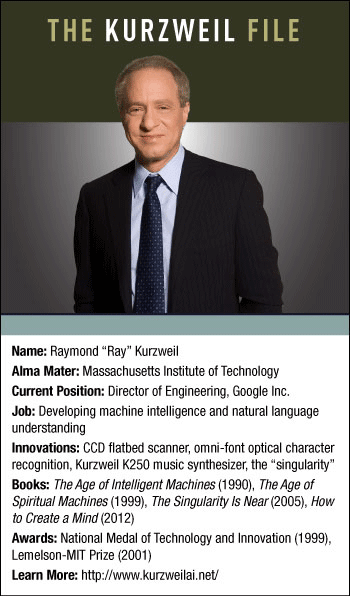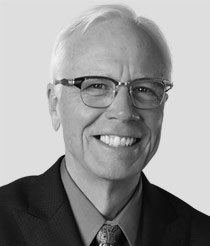You'd be hard pressed to find two guys more different than Warren Buffett and Google (Nasdaq: GOOG, GOOGL) Director of Engineering Ray Kurzweil.
Buffett, probably the world's most famous investor, had steered clear of high tech until just the last few years, saying he didn't understand the field.
Kurzweil, on the other hand, has pushed the boundaries of innovation for more than five decades. As a teenager, he created a groundbreaking computer program that could play classical music and netted him an appearance on the TV game show "I've Got a Secret."
He's never turned back, inventing omni-font optical character recognition, flat-bed scanners, text-to-speech programs, and artificial intelligence for trading the markets.
Now, he may be best known for his prediction that in the near future man and machine will become intertwined in an event he calls the "singularity."
Today, I want to tell you why Google is such an intriguing tech investment with enormous upside.
This industry leader has somehow combined Buffett's business genius and Kurzweil's futurist brain...
Google's (Nasdaq: GOOG, GOOGL) Not Standing Pat
As a former part-time musician, I've followed Kurzweil's work for many years now. His Kurzweil K250 synthesizers that debuted in 1984 redefined electronic music.
The sounds from those devices were so realistic that in some tests professionals couldn't tell the difference between a K250 and a real grand piano.
 A list of Kurzweil's many inventions would run several paragraphs. When it comes to high tech, few can match his track record.
A list of Kurzweil's many inventions would run several paragraphs. When it comes to high tech, few can match his track record.
So, when our favorite futurist took a high-profile Silicon Valley job two years ago, I was excited to see what he might come up with.
Kurzweil has said many times that the three areas most vital to the next phase of human development are what he calls "GNR" - genetics, nanotechnology, and robotics.
I certainly don't disagree with that.
And so I think you all should take a close look at Kurzweil's work at Google Inc. (Nasdaq: GOOG, GOOGL), where he's a director of engineering.
It's not well known, but even before Kurzweil's arrival, the Internet search giant had been making great strides in GNR through its secretive Google X facility.
First, in 2010, came a driverless car. And since then, we've seen Google Glass, glucose-monitoring contact lenses and other biotech projects, Project Wing (drone delivery), and Project Loon (Internet service via high-altitude balloons) come out of the Google X labs.
Wall Street analysts and other investors often criticize Google X's "science fiction-sounding solutions." They claim the company is preoccupied with futuristic technology and doesn't pay enough attention to core search products.
In a recent interview with the Financial Times, Google Chief Executive Officer Larry Page rejected that criticism outright. Page says he emulates none other than Warren Buffett, whose Berkshire Hathaway Inc. (NYSE: BRK.A) is the most successful conglomerate in history; shares of its Series A stock are currently priced at more than $217,000.
Page says he's on a mission to make Google the Berkshire Hathaway of high tech. He told FT that his "patient capital" approach will pay off handsomely for investors over the long haul - and I concur.
If Google wants to compete with Apple Inc. (Nasdaq: AAPL) and other tech leaders and up-and-comers, there's no way it can stand pat.
With that in mind, I want to let you know more about the fascinating breakthroughs Google is making in Kurzweil's GNR.
Let's take a look.
Genetics: Defeating Death
Google launched California Life Sciences LLC (aka Calico) last year to focus on anti-aging research.
Essentially, Page, Kurzweil, and other top executives at the Googleplex want to "cure" death.
Like Google X, Calico has been surrounded by mystery and even some controversy. Most new ventures seek attention and court press coverage. In the months that followed the unveiling, however, both Google and Calico remained very circumspect about their plans.
Calico recently announced a joint venture with biotech leader AbbVie Inc. (NYSE: ABBV). The two companies have agreed to invest up to $1.5 billion in drug research.
Now we know that Calico specializes in analyzing genetic data. The company's leader, current Apple Chairman and former Genentech Inc. CEO Arthur Levinson, intends to use this information to create innovative treatments for age-related diseases.
Here's Calico's mission: to identify what inside people makes them live longer or makes them prone to diseases. Calico scientists will use what they find to create new life-extending drugs.
Calico is set to build an R&D facility in the San Francisco region. The facility will house drug development and clinical trials.
Calico and AbbVie are targeting genetics-based research on cancers and neurodegenerative diseases such as Parkinson's and Alzheimer's.
Nanotech: Beating Cancer
Imagine a pill that will detect cancers and other diseases by sending out magnetic nanoparticles throughout your bloodstream that patrol your body.
Andrew Conrad, head of the Life Sciences team at Google X, has confirmed they're working on just that.
These nanoparticles are less than one-thousandth the width of a red blood cell. If the Googlers' designs work, the particles will bind themselves to cells, proteins, and other molecules inside the body and serve as a constant cancer early-warning system.
Google also is working on a wearable monitoring device - which will use a magnet to attract and count the particles.
The final product will take several years to pass a series of U.S. Food and Drug Administration clinical trials and reach the market. But that's true of all new drugs and medical devices.
Robotics: Hands-Free Driving
Just about every auto firm in the world and plenty of tech companies are working on driverless cars. But no one has done more for this field than Google.
To operate without steering wheels, Google's self-driving cars are equipped with complex software, a bevy of motion sensors, collision avoidance systems, 3D maps, and lasers.
In a recent blog entry, the project's director noted that Google "bot cars" have already logged more than 700,000 miles on the road. The program began in secret back in 2009.
But driverless cars are only the public face of Google's robotics efforts.
Behind the scenes, the Mountain View, Calif.-based company has moved aggressively. It's bought at least seven robotics firms in the last few years, including the pioneering Boston Dynamics, which makes four-legged pack bots for the Pentagon.
Search: Party On
Like I mentioned before, some critics say Google's fascination with futurism means it is ignoring its core online search business.
However, Kurzweil will be a big boost for the company here, too. He is one of the world's foremost experts on artificial intelligence - and he's confirmed that Google is building that technology into a next-gen search platform.
Thus, Google is a unique investment opportunity. Think of Google as an exchange-traded fund (ETF) that is stuffed with future-tech small caps - and that generates huge cash flow right now.
With a market cap of $371.9 billion, the stock trades at $555. It has operating margins of 23% and earns 14% on stockholders equity. Last year, it brought in $5.4 billion in free cash flow.
Larry Page is correct. Google stock has lagged the market over the past year and is a long-term play.
Here's a hint of the potential: Exactly 30 years ago last week, Berkshire Hathaway Series A stock was worth $1,300 a share, giving it a 16,054% return since then.
If GOOG stock did just 2% as well over the next 10 years, it would give us a 321% return. I bet Warren Buffett would like that.
Patient investors who realize Google (Nasdaq: GOOG, GOOGL), Page, and Kurzweil are building the ultimate company of the future will be richly rewarded.
More from Michael Robinson: Several "Ebola stocks" have seen their stock prices rise and fall recently on rumors about an Ebola vaccine. But this solid big-cap company is gearing up for a major Ebola drug trial and could have a product out in just seven months - and it's also a dividend aristocrat. Here's why this "Ebola stock" is the far better bet...
About the Author
Michael A. Robinson is a 36-year Silicon Valley veteran and one of the top tech and biotech financial analysts working today. That's because, as a consultant, senior adviser, and board member for Silicon Valley venture capital firms, Michael enjoys privileged access to pioneering CEOs, scientists, and high-profile players. And he brings this entire world of Silicon Valley "insiders" right to you...
- He was one of five people involved in early meetings for the $160 billion "cloud" computing phenomenon.
- He was there as Lee Iacocca and Roger Smith, the CEOs of Chrysler and GM, led the robotics revolution that saved the U.S. automotive industry.
- As cyber-security was becoming a focus of national security, Michael was with Dave DeWalt, the CEO of McAfee, right before Intel acquired his company for $7.8 billion.
This all means the entire world is constantly seeking Michael's insight.
In addition to being a regular guest and panelist on CNBC and Fox Business, he is also a Pulitzer Prize-nominated writer and reporter. His first book Overdrawn: The Bailout of American Savings warned people about the coming financial collapse - years before the word "bailout" became a household word.
Silicon Valley defense publications vie for his analysis. He's worked for Defense Media Network and Signal Magazine, as well as The New York Times, American Enterprise, and The Wall Street Journal.
And even with decades of experience, Michael believes there has never been a moment in time quite like this.
Right now, medical breakthroughs that once took years to develop are moving at a record speed. And that means we are going to see highly lucrative biotech investment opportunities come in fast and furious.
To help you navigate the historic opportunity in biotech, Michael launched the Bio-Tech Profit Alliance.
His other publications include: Strategic Tech Investor, The Nova-X Report, Bio-Technology Profit Alliance and Nexus-9 Network.



